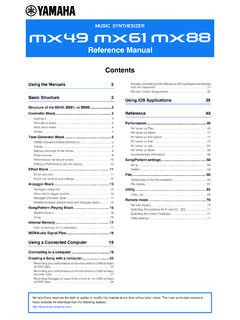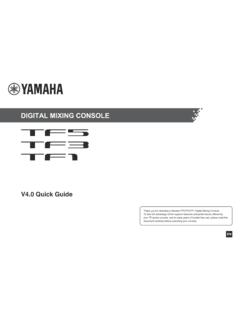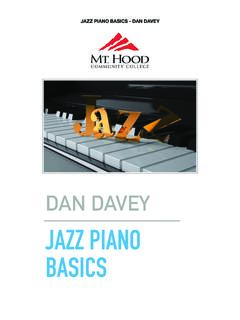Transcription of MIDI Basics - Yamaha Corporation
1 1 midi Basics1. What s midi ? .. 12. What You Can Do With midi .. 23. midi Channels .. 34. midi Messages .. 41. What s midi ? midi is an acronym that stands for Musical Instrument Digital Interface, a technology that allows electronic musical instruments to communicate with each other, by sending and receiving performance what do we mean by performance information ? Let s consider what happens when a pianist pianist presses a key on a piano or presses a pedal. These actions are instances of performance information and reflect how the pianist played the instrument. midi is used to capture and express this information electronically.
2 When you strongly play middle C on a midi keyboard, midi indicates the key number as 60, and the strength of playing as 120, for exam-ple. In this way, midi precisely describes your performance infor-mation in digital performance information midi data can be transmitted between midi -compatible musical instruments, or saved as a file for later playback. No matter what instrument or computer you use, the midi data will reproduce the original per-formance exactly the same. (Keep in mind that the actual sound of the performance may differ from instrument to instrument for example, the acoustic piano sound on one instrument may sound more full and rich than on another but the basic perfor-mance will be identical.)
3 The midi data saved as a file can easily be changed. For example, you can change an incorrectly played note to the cor-rect one, change the song tempo, transpose the song to a desired key, etc. This feature of midi is very effective for creating a song or practicing with a musical What You Can Do With MIDIBy connecting multiple midi devices (musical instruments and/or computer) with a cable, the midi data can be transmitted and received. For example, if you record your keyboard performance as a midi data, the recorded data can be transmitted to another instrument (or computer) and played back on it. You can even edit that data on the computer.
4 You can also buy midi data (computer files) of your favorite songs from Internet websites (such as ) and listen to the data by playing it back on your instrument or , midi cable is used for connecting an instrument to another instrument, and USB cable is used for connecting instruments to a computer. For details, refer to the owner s manual of your data has the following advantages over audio data: The data size is much smaller than audio data such as mp3, wav, etc. The data can be effectively and easily edited.(Example 1)Using one keyboard to control a second, connected keyboard(Example 2)Recording your keyboard performance to computer and editing the dataEdited data can be played back on the keyboard sequencer software must be installed to the computer in order to edit midi data.
5 (Example 3)Playing back midi data which you have bought from an Internet website on your instrumentThe midi data can be loaded to your instrument via USB flash order to connect USB flash memory, your instrument must have a USB TO DEVICE instrumentMIDI transmitMIDI OUTMIDI INMIDI instrumentUSB cableUSB TO HOSTUSBC omputerNOTEUSB flash memoryUSBUSB TO DEVICEI nternet websiteMIDI instrumentNOTE33. midi ChannelsMIDI performance data is assigned to one of sixteen midi channels. Using these channels, 1 16, the performance data for sixteen different instrument parts can be simultaneously sent over one example, when you play a song on your keyboard, the song contains many parts right-hand part, left-hand part, rhythm part, bass part, etc.
6 On most instruments, different midi channels are assigned automatically to each part. When this midi song is transmitted to another instrument via a midi cable, each part is transmit-ted simultaneously, yet over separate (track) of your instrumentMIDI Transmit ChannelMIDI Receive ChannelTrack of instrument receiving midi dataRight-hand partCh. 1Ch. 1 Track 1 Left-hand partCh. 2Ch. 2 Track 2::::Rhythm 1 partCh. 9Ch. 9 Track 9 Rhythm 2 partCh. 10Ch. 10 Track 10 Bass partCh. 11Ch. 11 Track 11:::::Ch. 16Ch. 16 Track 16 midi instrumentMIDI transmitMIDI cableMIDI OUTMIDI INMIDI sequencer44. midi MessagesMIDI data (messages) can be divided into two groups: Channel messages and System following explanation shows an example of midi messages.
7 For more details about midi messages for example, when you want to edit the recorded midi data please refer to any of the fine midi guidebooks that are commercially available. Channel MessagesWhen you perform on a midi instrument, the following messages are Message Examples System MessagesThis is data that is used in common by the entire midi system. These include System Exclusive Messages for transferring data unique to each instrument manufacturer and Realtime Messages for controlling the midi messages transmitted/received by your instrument are shown in the midi Data Format and midi Implementa-tion Chart included in your OperationMessagesPlaying the keyboardNote On/Off (When the key was played/released)Note Number (Which key was played)Velocity (How strong the key was played)Selecting a VoiceProgram ChangeChanging the volume, pressing Sustain Pedal, ChangeMoving the Pitch Bend WheelPitch BendPressing the key down after the note is playedAfter TouchNOTE
















